This Dairy-free Chicken Saag is one of the most popular Indian recipes. I made it a clean keto-approved recipe!
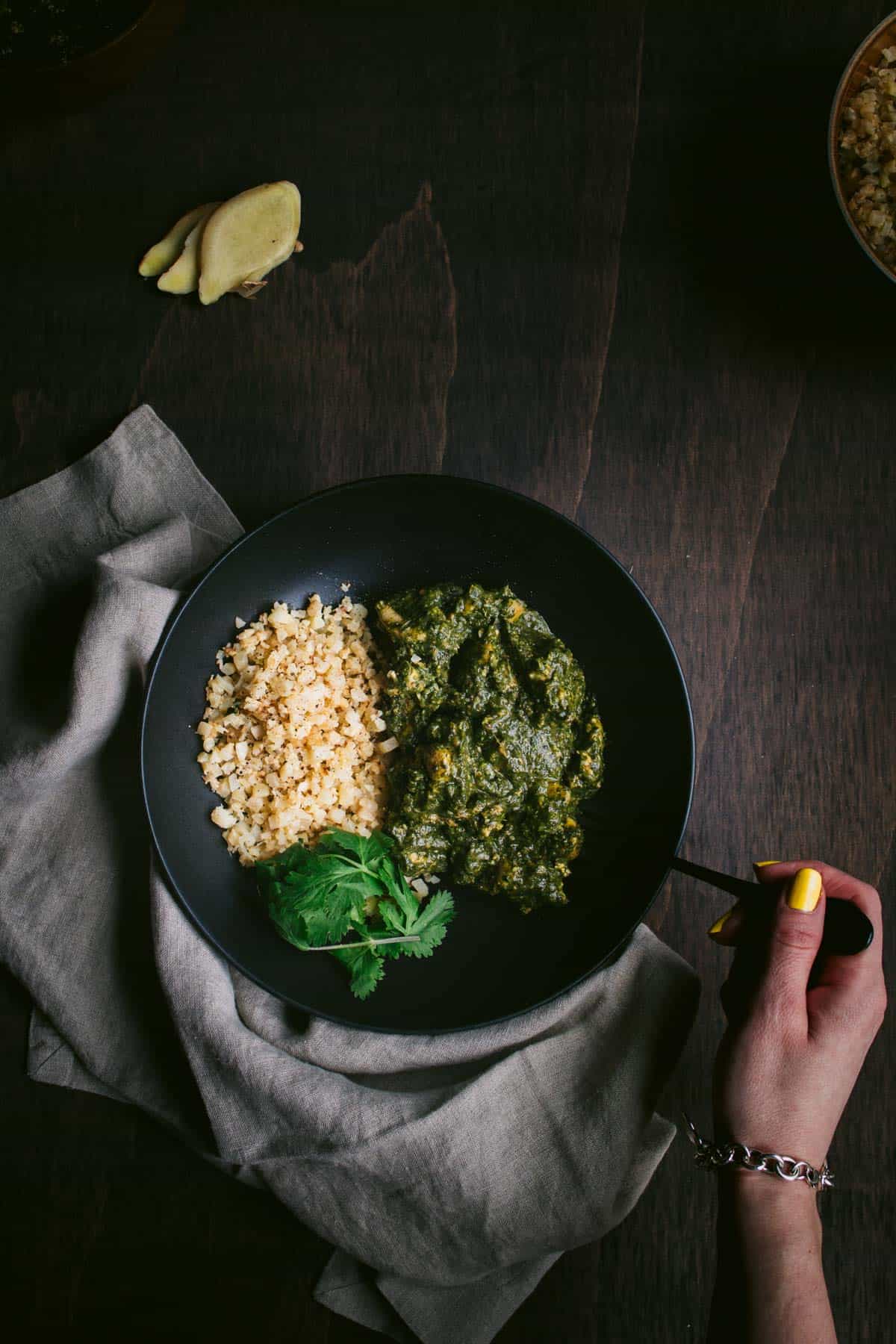
This simple curry is a weeknight winner! With only 15 minutes of prep time and 25 minutes to cook, this will be ready on the table as quickly as your Uber-eats order. Except this version will be much healthier!
What is Chicken Saag?
Chicken saag, also known as saag murgh or palak chicken, is a traditional Indian dish that combines marinated chicken with a flavorful spinach sauce.
The sauce is made from a blend of spices, including cumin, coriander, turmeric, and garam masala, which contribute to its rich and aromatic flavor profile.
The dish is not only tasty but also nutritious, as it’s packed with vitamins, minerals, and protein from both the chicken and spinach.
The Origins of Chicken Saag
While the exact origins of chicken saag are difficult to pinpoint, it’s believed to have roots in the Punjab region of India and Pakistan, where spinach and mustard greens are widely cultivated.
The dish’s name comes from the combination of two words: “saag,” which refers to leafy green vegetables such as spinach, mustard greens, or collard greens, and “murgh” or “chicken.”
Saag dishes have been part of the Indian subcontinent’s culinary repertoire for centuries. The use of leafy greens can be traced back to ancient Ayurvedic practices, which emphasize the importance of incorporating greens for their health benefits.
As spinach was introduced to the region through trade and cultural exchanges, it became a popular ingredient in saag recipes.
The Mughal Influence
The Mughal Empire, which ruled parts of the Indian subcontinent between the 16th and 19th centuries, had a significant impact on the cuisine of the region.
The Mughals introduced Persian cooking techniques and ingredients, which heavily influenced the development of many Indian dishes, including chicken saag.
The Mughals were known for their love of rich and elaborate meals, often featuring meat dishes cooked in creamy, aromatic sauces.
As a result, chicken saag evolved into the creamy, spinach-based dish we know and love today, with the signature blend of spices and smooth texture reflecting the fusion of Indian and Persian culinary traditions.
The Global Spread of Chicken Saag
With the growing popularity of Indian cuisine across the globe, chicken saag has found its way into the hearts and kitchens of people from various cultures.
The dish’s unique blend of flavors and healthful ingredients has made it a favorite in countries such as the United Kingdom, the United States, and Canada.
Today, chicken saag continues to evolve as chefs and home cooks adapt the dish to suit local tastes and dietary preferences.
From keto-friendly and low-carb versions to vegan alternatives using tofu or paneer, chicken saag remains a versatile and beloved part of Indian cuisine
is chicken saag keto-friendly?
The ketogenic (keto) diet has gained immense popularity in recent years, with many people adopting it for its potential health benefits, such as weight loss and improved mental clarity.
The keto diet primarily focuses on consuming high amounts of healthy fats and moderate protein while keeping carbohydrate intake to a minimum.
As more people embrace this lifestyle, a common question arises: can popular dishes from various cuisines fit into the keto diet? In this blog post, we’ll explore the compatibility of a classic Indian dish – chicken saag – with the keto diet.
Understanding Chicken Saag
Chicken saag is a popular Indian dish that traditionally consists of tender, marinated chicken pieces cooked in a rich and flavorful spinach-based sauce.
The dish is known for its exquisite blend of spices, including cumin, coriander, turmeric, and garam masala.
It’s not only delicious but also nutritious, as it’s packed with vitamins, minerals, and protein.
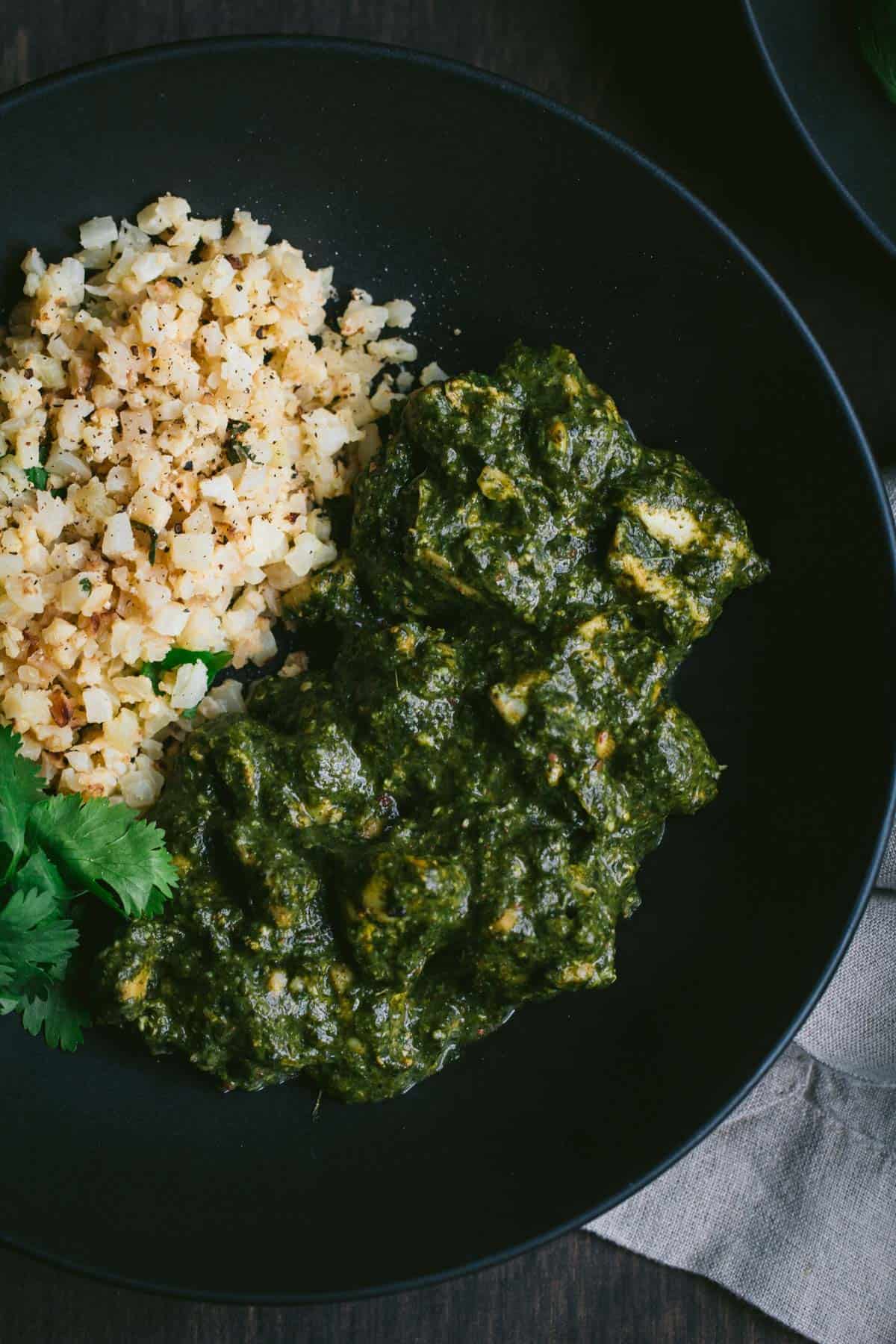
Is Chicken Saag Keto-Friendly?
At first glance, chicken saag appears to be a suitable option for those following a keto diet.
The dish is primarily made up of chicken and spinach, both of which are keto-friendly ingredients.
Chicken is an excellent source of protein and contains healthy fats, while spinach is low in carbs and rich in essential nutrients like vitamins A, C, and K, as well as iron and calcium.
However, the compatibility of chicken saag with the keto diet depends on the specific recipe and preparation method.
Some variations may include ingredients that are not keto-friendly, such as tomatoes, onions, or yogurt.
Additionally, certain spices or thickeners may introduce a higher carb count, which could potentially impact ketosis.
If you’re looking to enjoy chicken saag while adhering to your keto diet, consider the following tips:
- Opt for recipes that use minimal amounts of high-carb ingredients, such as tomatoes and onions, or substitute them with keto-friendly alternatives like green bell peppers or scallions.
- Avoid recipes that call for sugar or other sweeteners, as these can increase the carb count. Instead, rely on the natural sweetness of the spices and ingredients to create a delicious flavor profile.
- Use full-fat dairy products, like heavy cream or coconut milk, instead of low-fat yogurt or cream to maintain the high-fat content required for ketosis.
- Be mindful of portion sizes. While chicken saag can be keto-friendly, consuming excessive amounts can still lead to an increased carb intake.
What is saag made of?
If you’ve dined at Indian restaurants or got Indian takeout, you likely would have seen several dishes with the word ‘saag’ in the name.
‘saag’ refers to the leafy green vegetables commonly found on the Indian subcontinent (including India, Pakistan, Nepal, etc.). These leafy greens include spinach, collard greens, basella, mustard greens, fenugreek, and dill.
This dairy-free chicken saag recipe uses explicitly spinach. You’ll need mature spinach, rather than baby spinach. Mature spinach is hardier compared to baby leaves, which are too delicate for this type of recipe.
You can also use frozen spinach, but if you do, allow it to defrost, then drain and dry it out before use. If you don’t do this important first step, you’ll find your saag chicken to be very ‘wet’.
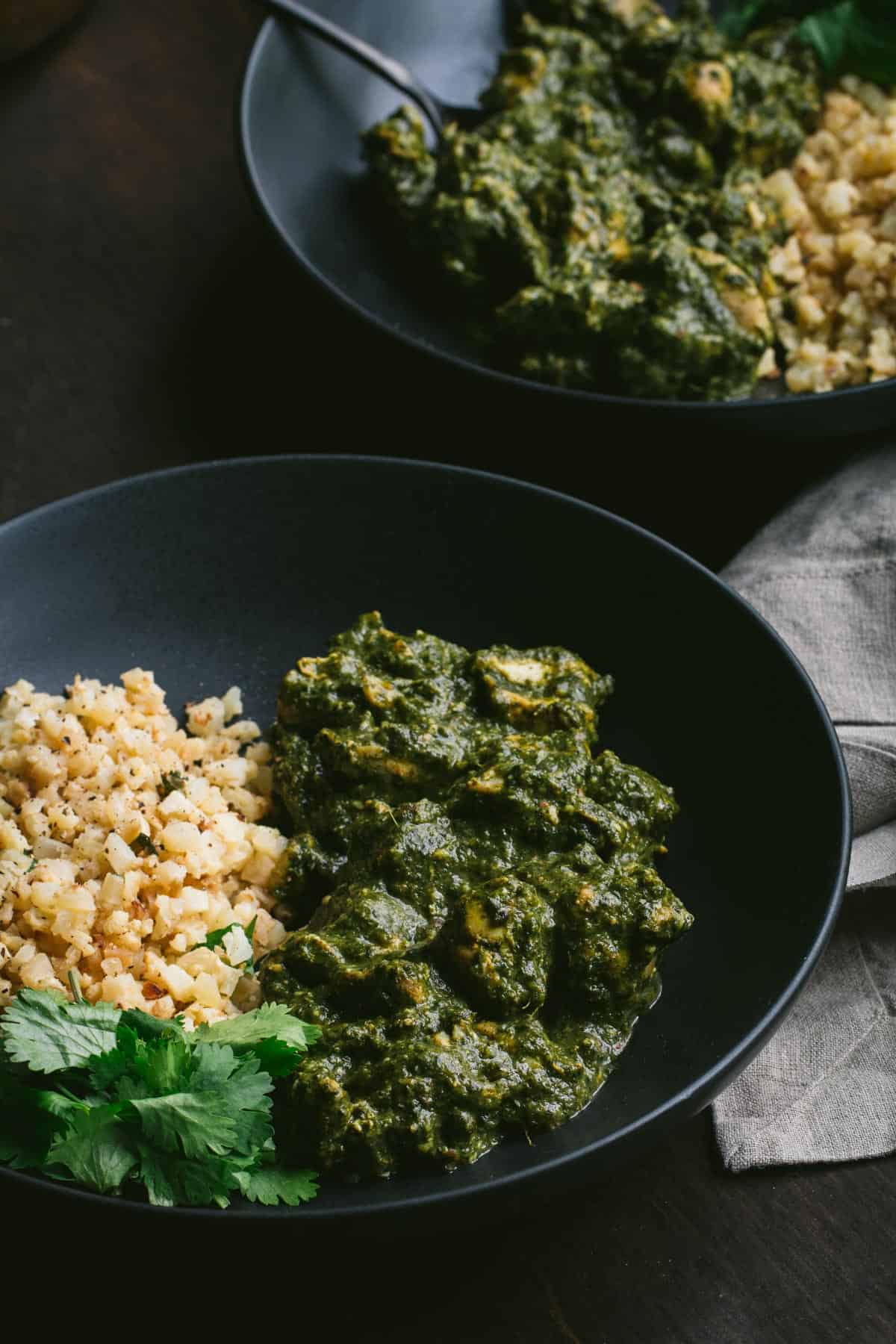
Dairy-free Saag
Creamy saag dishes will often use cream, but to make this version dairy-free, we will use coconut cream.
You’ll notice though, that this recipe calls for ghee. So you may be wondering if this recipe actually is dairy-free.
Ghee is made from butter. More specifically, ghee is a type of clarified butter that originated in ancient India.
Ghee is typically prepared by simmering butter, skimming any impurities from the surface, and then pouring out and setting aside the clear liquid fat. The final step is discarding the solid residue that had settled to the bottom. This process means that all the milk solids are completely removed during production.
This means that technically, ghee is not dairy-free because it is butterfat. However, it’s lactose-free.
So if you’re avoiding dairy because you’re lactose intolerant, ghee is a safe option for you.
Saag dishes are often served on bread such as naan or roti, but in this low-carb version of Dairy-Free Chicken Saag, I serve it over cauliflower rice.
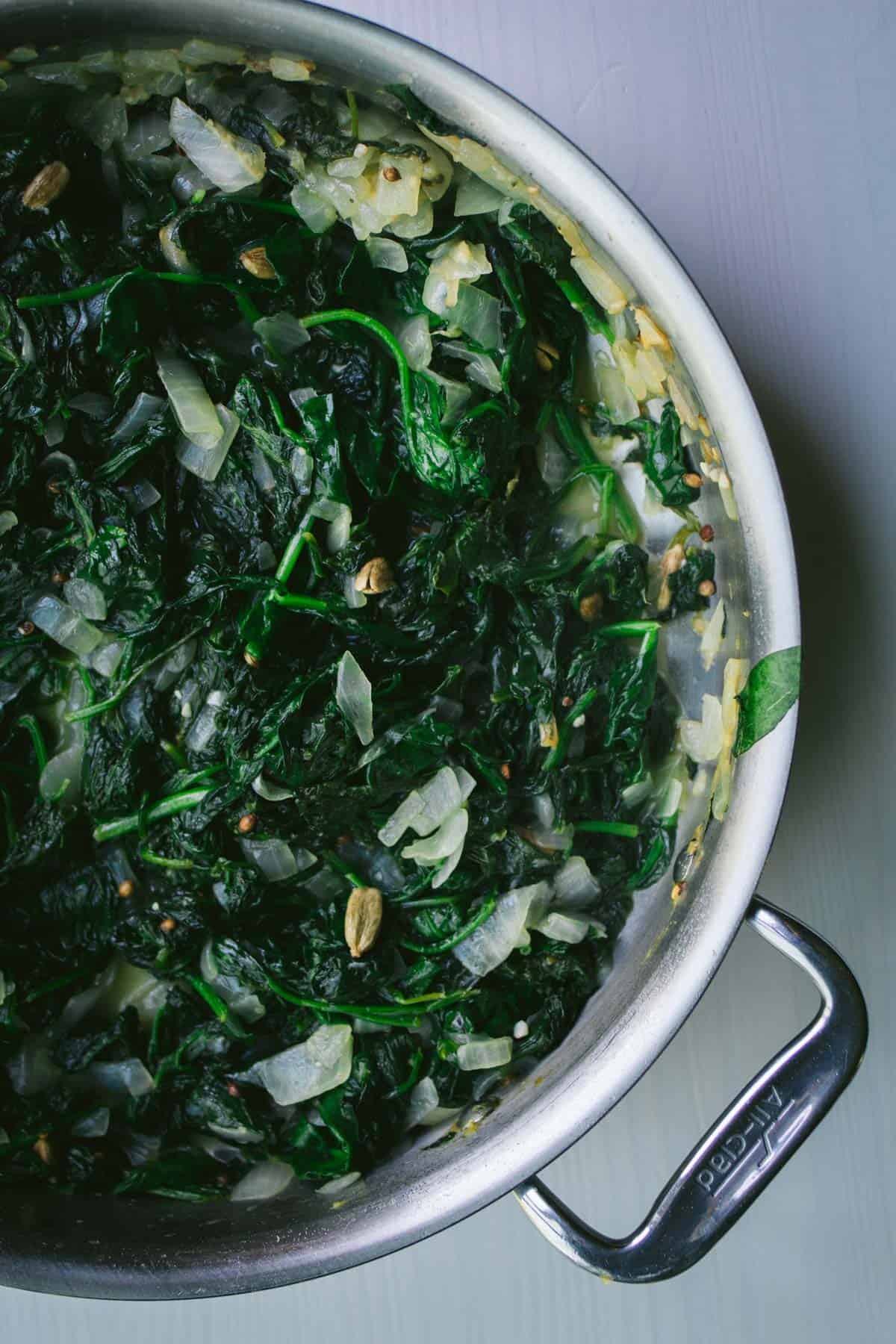

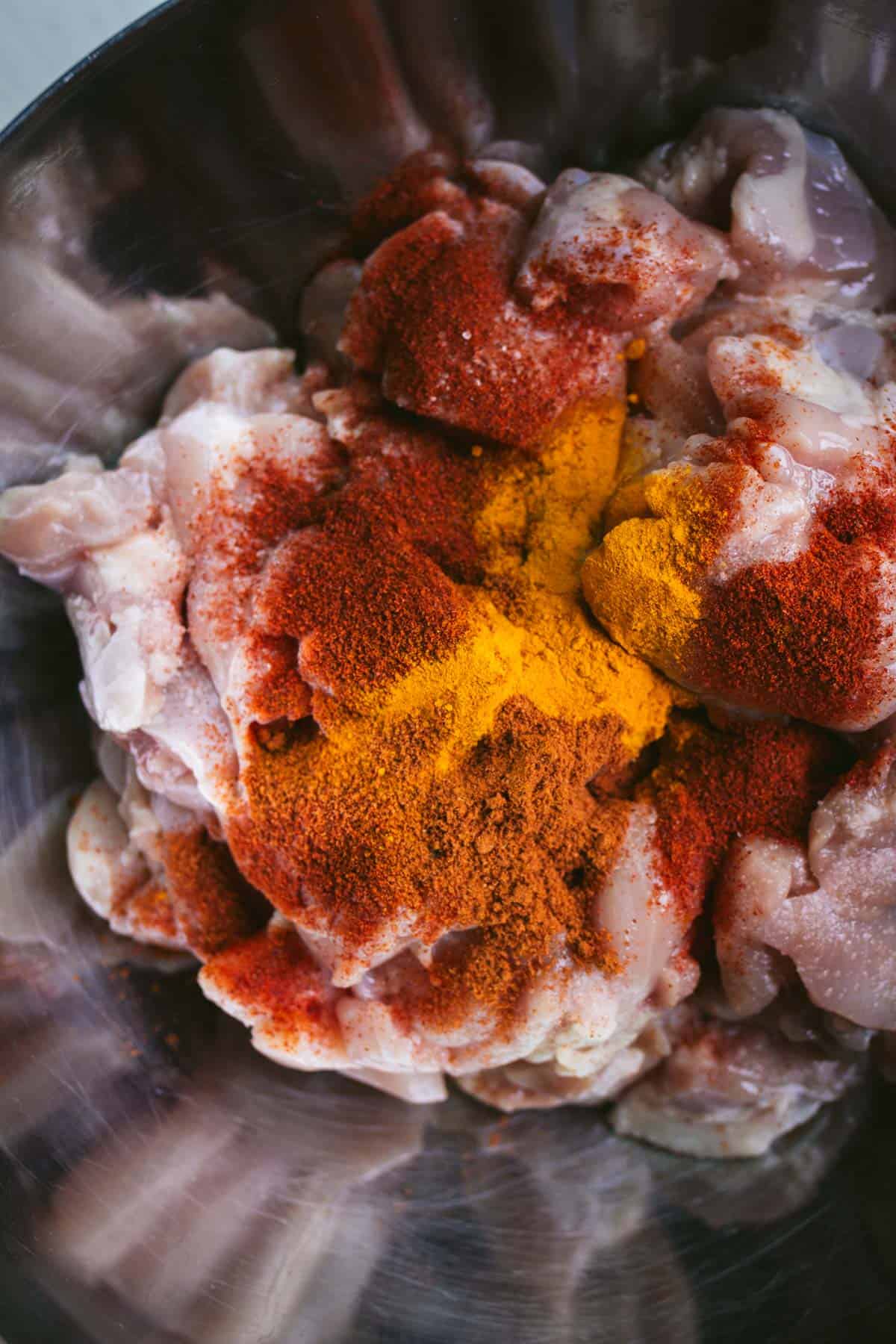
Tips and tricks for a low-carb chicken saag
Minimize high-carb vegetables
Traditional chicken saag recipes often include tomatoes and onions, which can contribute to the overall carb count. To reduce carbs, use smaller quantities of these ingredients or replace them with low-carb alternatives such as green bell peppers, scallions, or even shallots, which have a slightly lower carb content than onions.
Choose low-carb thickeners
Some chicken saag recipes use thickeners like cornstarch or flour to achieve a creamier consistency. To maintain a low-carb profile, opt for keto-friendly thickeners like xanthan gum, guar gum, or even a small amount of almond or coconut flour.
Omit sugar and sweeteners
Traditional recipes may call for sugar or other sweeteners to balance the flavors. Instead of using these high-carb ingredients, rely on the natural sweetness of spices or consider adding a pinch of a low-carb sweetener like erythritol or stevia.
Use low-carb spices and seasonings
Most spices used in chicken saag are low in carbohydrates, but it’s essential to be mindful of the amounts used. Ensure that you measure the spices accurately to keep the carb count in check.
Opt for full-fat dairy products
To maintain the low-carb, high-fat profile, use full-fat dairy products like heavy cream or full-fat coconut milk instead of low-fat yogurt or cream.
Serve with low-carb sides
Traditional Indian dishes are often served with high-carb sides like rice or naan. To keep the entire meal low-carb, serve your chicken saag with cauliflower rice, keto-friendly naan, or a simple green salad.
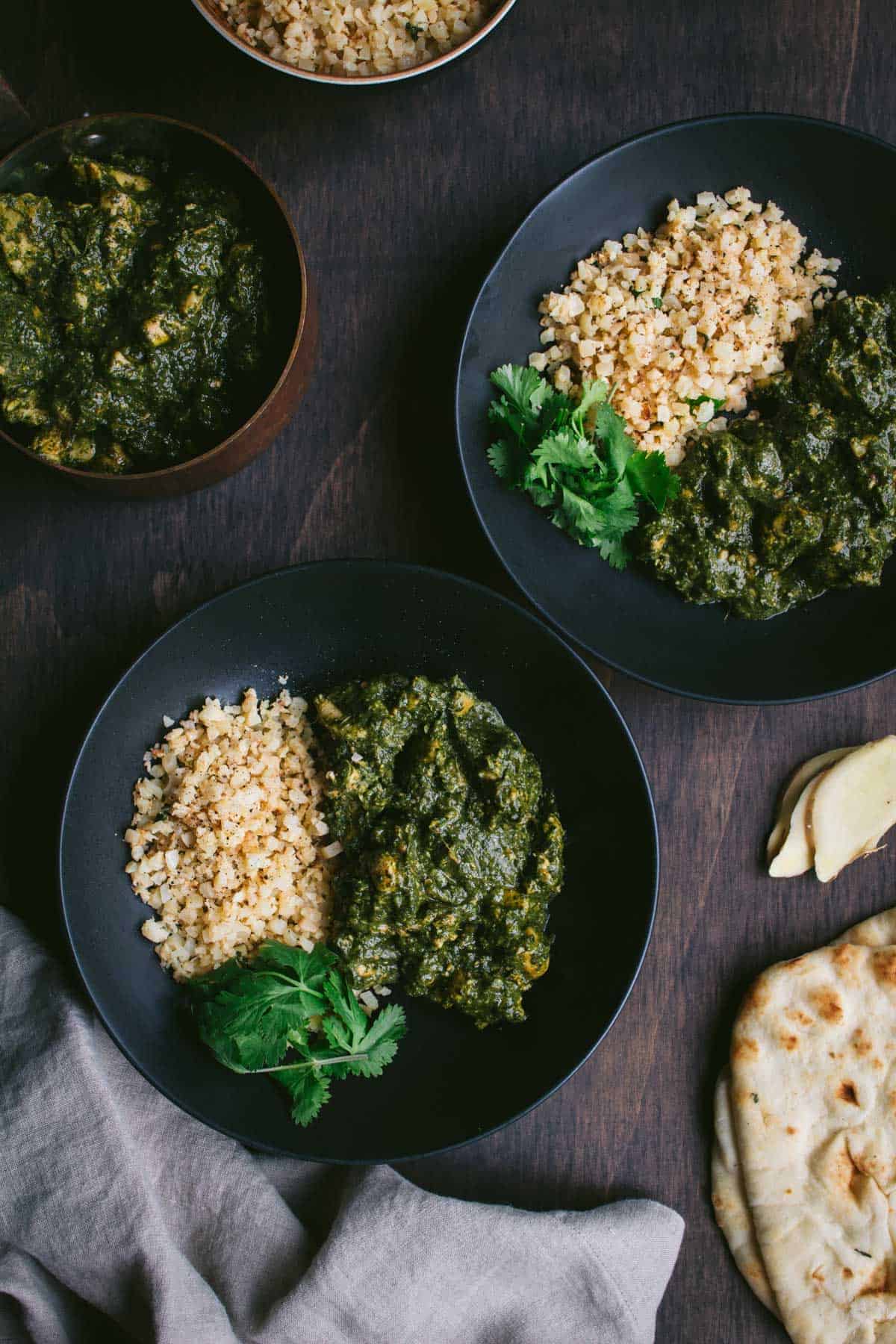
tips and tricks for making the best keto chicken saag
Use keto-friendly vegetables
Limit the use of high-carb vegetables like onions and tomatoes.
Replace them with lower-carb alternatives, such as green bell peppers, scallions, or shallots, which have a slightly lower carb content than onions.
Opt for full-fat dairy products
The keto diet emphasizes high fat intake.
Use full-fat dairy products like heavy cream or full-fat coconut milk instead of low-fat yogurt or cream to maintain the high-fat content necessary for ketosis.
Choose the right chicken cut
Opt for chicken thighs over chicken breasts, as thighs contain more fat and provide a richer flavor that complements the keto diet.
Be mindful of spices and seasonings
While most spices used in chicken saag are low in carbohydrates, it’s essential to measure them accurately to avoid adding extra carbs to your dish.
Avoid spice blends that may contain added sugars or starches.
Eliminate or replace sweeteners
Traditional chicken saag recipes may call for sugar or other sweeteners.
Skip these high-carb ingredients and use a pinch of a low-carb sweetener like erythritol or stevia if necessary.
Thicken the sauce with keto-friendly options:
Some chicken saag recipes use cornstarch or flour as thickeners.
Instead, use keto-friendly thickeners like xanthan gum, guar gum, or a small amount of almond or coconut flour to achieve the desired consistency without increasing the carb count.
Control portion sizes
Be mindful of portion sizes to ensure you don’t consume too many carbs.
Chicken saag can be keto-friendly, but excessive amounts can still lead to an increased carb intake.
Serve with keto-friendly sides:
Pair your chicken saag with low-carb sides like cauliflower rice, keto naan, or a simple green salad to complete your keto meal.
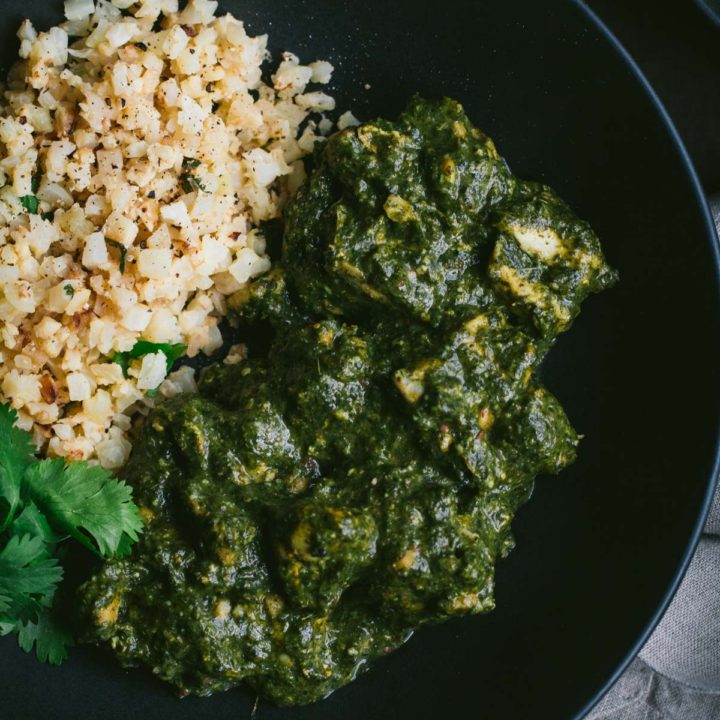
Dairy-Free Chicken Saag
Ingredients
- 1/4 cup ghee
- 1 tbsp coriander seed
- 1 tbsp cardomon pods
- 1 large onion
- 4 cups spinach
- 3 garlic clove
- 1 tbsp ginger paste
- 1 tsp salt
- 2 lbs chicken thighs
- 2 tsp chili powder
- 1/2 tsp turmeric
- 1 can of coconut cream
Instructions
- Melt half of the ghee in a large skillet. Add coriander and cardamon pods. Toast. Add onion and cook until translucent. Add ginger and garlic. Add spinach and cook until wilted. Season with salt.
- Transfer the mixture to a blender or food processor and blend until combined. Add back to the pan.
- Meanwhile, prep the chicken. Combine the rest of the ghee, chili powder, and turmeric in a medium bowl. Season with salt and pepper. Add chicken and toss well to combine.
- Add chicken to the Saag sauce and cook. Add in the coconut cream and simmer for 5 minutes. Season with salt and pepper and serve over cauliflower rice.
Nutrition Information
Serving Size 1Amount Per Serving Calories 312Total Fat 22gCarbohydrates 4gFiber 1gProtein 24g


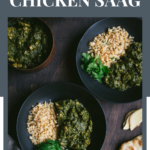
I was blown away on how much flavor this dish had, without the cream! I love Indian food and this was amazing.
What size can of coconut cream should be used for this recipe? My grocery store sells a 5-6oz can and a 14oz can.
Hi Keven! For this recipe, you’ll want to use the 14oz can of coconut cream. The larger size ensures you have enough to achieve the rich, creamy texture that makes this dish so delightful. Let me know how it turns out for you!